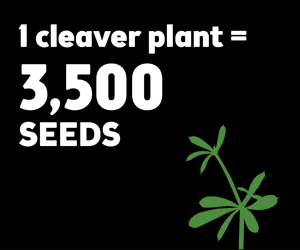| |
| |
 |
| |
 |
|
MMMM d, yyyy |
|
| |
 Farmland in the province is taxed at a ratio of between zero and 25 per cent of the residential rate – but some of the increases set to kick in are steep.
» Read more...
Farmland in the province is taxed at a ratio of between zero and 25 per cent of the residential rate – but some of the increases set to kick in are steep.
» Read more...
Robert Nurse, a research scientist with Agriculture and Agri-Food Canada (AAFC), has been working with AAFC colleagues Marie-Josée Simard and Stephen Darbyshire to investigate some aspects of woolly cupgrass and its control.
» Read more...
Researchers are suggesting there can be yield benefits to retaining some of the water escaping through drain tile during the growing season through the use of water flow control structures added to tile-drained systems.
» Read more...
|
| |
|
| |

It only takes one weed to spread the seeds of destruction in a cereal crop. A cleavers plant can produce 3,500 seeds. A single chickweed plant can generate 20,000 seeds. And one ragweed plant is capable of producing a staggering 62,000 seeds.
Target your toughest weeds with Nufarm’s hard-hitting portfolio of cereal products.
- New Enforcer® M delivers effective post-emergent control of all these tough weeds, and more.
- Boost® M knocks down chickweed, winter annuals and the most common annual broadleaf weeds.
- Estaprop® XT provides outstanding control of ragweed and dandelion in a cereal rotation.
>> Learn more |
| |
|
| |
 With the introduction of Monsanto’s glyphosate- and dicamba-resistant soybean into the Canadian market in 2017, producers may be wondering if there is any benefit to tank-mixing the two herbicides for weed control. It’s an apt question given the development of glyphosate-resistant weeds such as giant ragweed, common ragweed, Canada fleabane and waterhemp.
» Read more...
With the introduction of Monsanto’s glyphosate- and dicamba-resistant soybean into the Canadian market in 2017, producers may be wondering if there is any benefit to tank-mixing the two herbicides for weed control. It’s an apt question given the development of glyphosate-resistant weeds such as giant ragweed, common ragweed, Canada fleabane and waterhemp.
» Read more... |
| |
 Glyphosate-resistant Canada fleabane is very difficult to control in soybean: studies have shown it emerges 11 out of 12 months of the year in southern Ontario. For producers with multiple-resistant fleabane, there are no post-emergence herbicide options for control in soybean. But those producers with glyphosate-resistant Canada fleabane still have a few chemical options.
» Read more...
Glyphosate-resistant Canada fleabane is very difficult to control in soybean: studies have shown it emerges 11 out of 12 months of the year in southern Ontario. For producers with multiple-resistant fleabane, there are no post-emergence herbicide options for control in soybean. But those producers with glyphosate-resistant Canada fleabane still have a few chemical options.
» Read more... |
| |
|
| |
|
|
| |
| |





